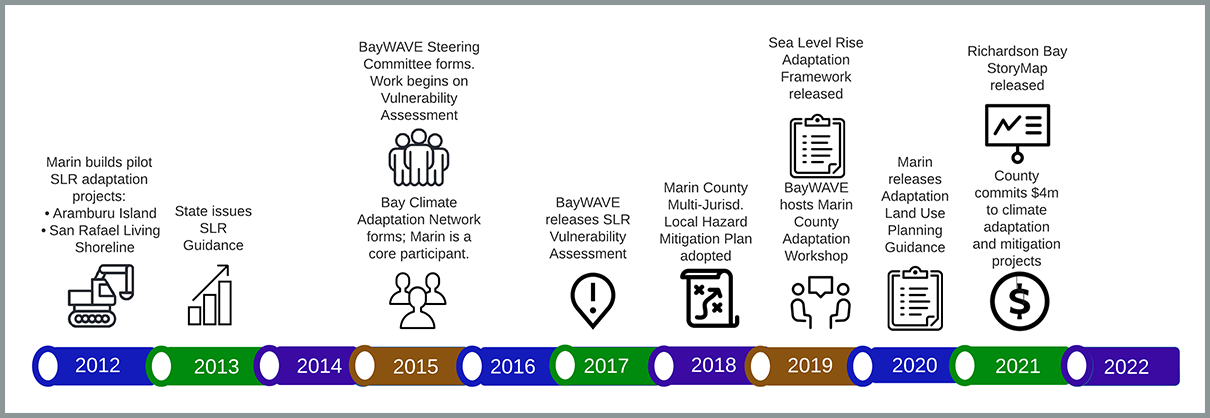BayWAVE: Sea Level Rise and Marin's Bayside
What is BayWAVE?
Rising seas threaten Marin County's Bay shoreline and ocean coast-- with some areas already experiencing flooding during high tides and storms. Two ongoing County planning programs coordinate with one another to address these issues:
- Marin County Department of Public Works leads the BayWAVE program for East Marin's bay shoreline
- Marin County Community Development Agency leads the C-SMART program for West Marin’s ocean coast
BayWAVE coordinates with all of East Marin's cities and towns to provide an ongoing public process that helps local communities understand and prepare for sea level rise.
BayWAVE's multi-jurisdictional coordination is critical, as sea level rise crosses political boundaries to impact our shared resources, utilities, and infrastructure.
Click on the timeline below to learn how BayWAVE has grown and some of its key successes!

- Timeline description
Timeline conveys key sea level rise actions by the County and BayWAVE from 2012 to 2022. In 2012, Marin County build pilot adaptation projects at Aramburu Island and San Rafael Living Shoreline. In 2013, the State issued sea level rise guidance. In 2015, the BayWAVE Steering Committee formed and work began on the Vulnerability Assessment. Also, Marin was a core member in the formation of the Bay Climate Adaptation Network. In 2017, BayWAVE released the sea level rise Vulnerability Assessment, and in 2018 the County adopted a Multi-Jurisdictional Local Hazard Mitigation Plan. In 2019, the Sea Level Rise Adaptation Framework was released and BayWAVE hosted a Marin County Adaptation Workshop. In 2020, the County released Adaptation Land Use Planning Guidance. In 2021, the Richardson Bay StoryMap was released and the County committed $4,000,000 to climate adaptation and mitigation projects
What is the BayWAVE Vulnerability Assessment?
In 2017, BayWAVE completed the Marin Shoreline Sea Level Rise Vulnerability Assessment, a technical report detailing how shoreline flooding will worsen with sea level rise if no actions are taken.
Visit the BayWAVE Vulnerability Assessment page to learn more and access the report.
What is being done now to adapt to sea level rise?
Adapting to sea level rise and addressing our communities' climate change resilience needs requires educational outreach, diverse partnerships, and on-the-ground projects.
Educational Outreach: From school programs and field trips to living room talks and national conferences, BayWAVE works to communicate sea level rise issues and the adaptation decisions facing our communities in clear, accessible ways. Visit our Get Involved page to learn how you can participate in Marin County sea level rise educational outreach.
Partnerships: BayWAVE works across County Departments, as part of Bay Area regional collaboratives, and in partnership with research institutions, state agencies, and federal partners to share information, coordinate resources, and promote adaptation. Our BayWAVE Steering Committee of local jurisdiction representatives ensures coordination and partnerships remain at the center of our approach and efforts.
Projects: From conceptual designs to "shovel ready", sea level rise adaptation projects are progressing in many parts of Marin. Visit our Adaptation Planning page to see a map of projects in Marin and access local sea level rise resources.
What are some of the big challenges to sea level rise adaptation?
- Sea level rise is a shared issue—floodwaters do not stop at jurisdictional boundaries. This means solutions require cooperation across cities, towns, and even counties. And of course, projects to address sea level rise require willing landowners, meaning both public and private properties often have to be on board to deliver holistic solutions.
- Addressing sea level rise in one place can have unintended impacts on other places. Understanding these interrelationships is complex; it requires close coordination, shared science, and lots of work to get at shared agreement on what actions to take, when to take them, and how to fund them.
- As we address near-term sea level rise impacts, we need to retain the flexibility to plan for and respond to longer term impacts. Basically, we need to act now in ways that don’t prevent us taking effective actions in the future.
- Project permitting can be difficult and very expensive, even for adaptation projects that achieve environmental and public safety benefits. While some regulatory approaches are evolving to recognize the unique context of sea level rise, they continue to slow progress and drive up project costs.